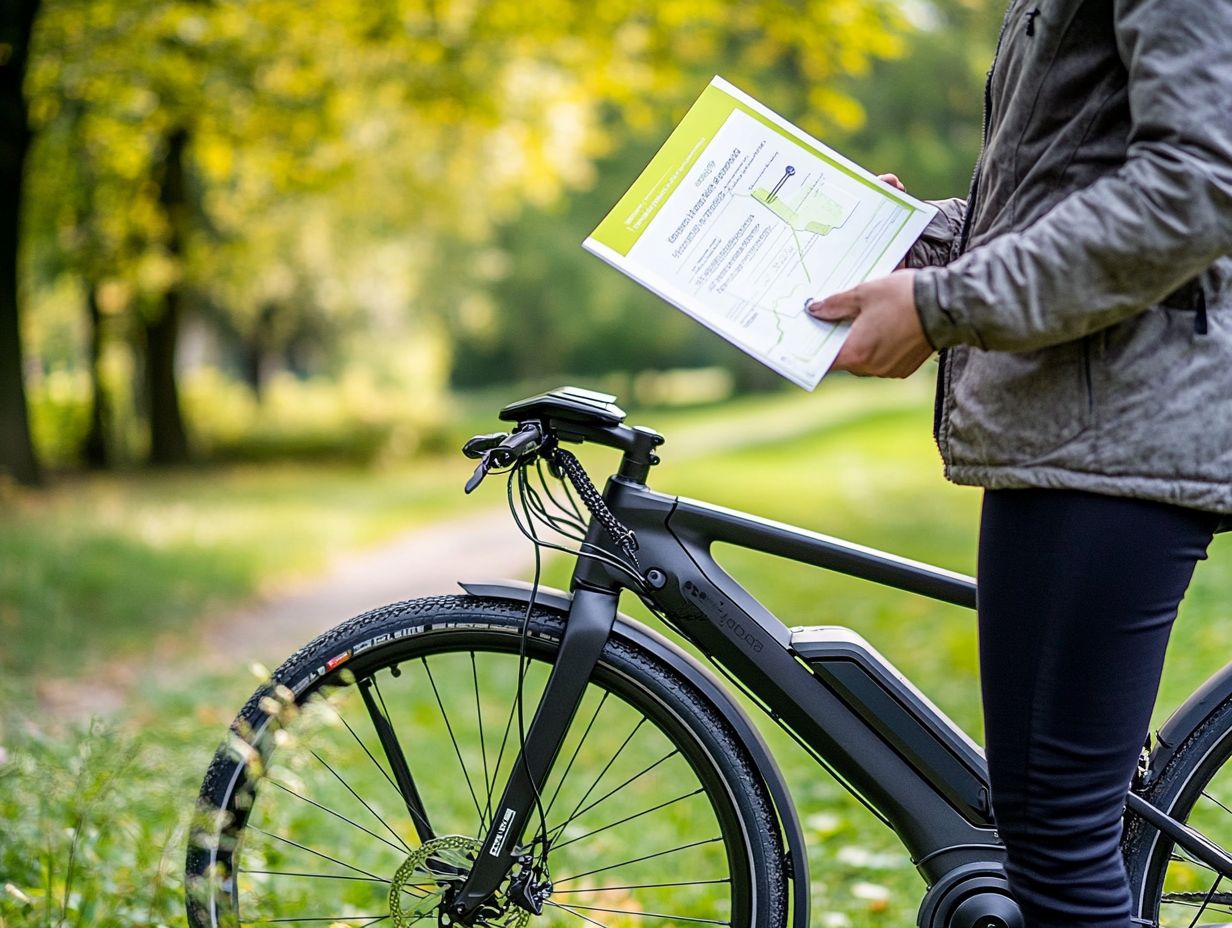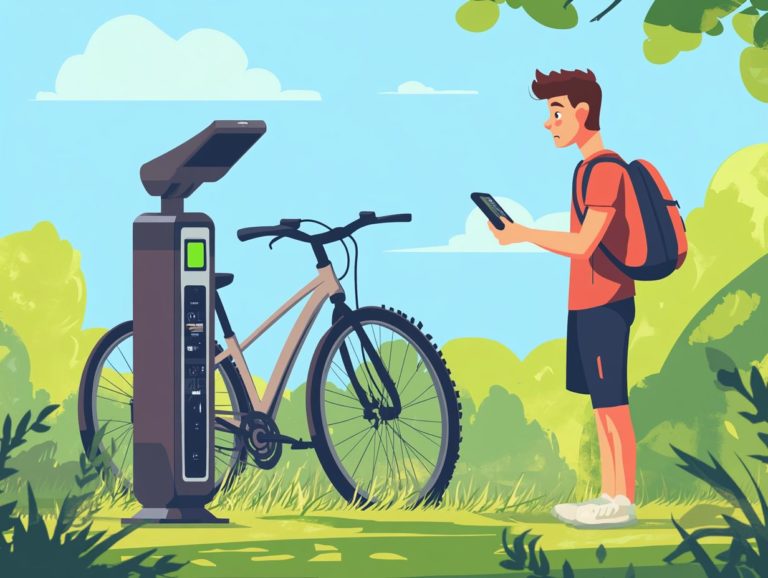Are There E-Bike Grants or Subsidies?
As e-bikes continue to rise in popularity for their convenience and eco-friendliness, you may find yourself wondering how to make this sustainable transportation option more affordable.
E-bike grants and subsidies can significantly lighten the financial load, enabling you and your community to adopt greener commuting solutions with ease.
This article delves into various funding opportunities, including government programs and initiatives from non-profit organizations.
You ll find insights on eligibility requirements, application processes, and the benefits these grants offer, along with potential challenges and viable solutions.
Don t miss out on these amazing resources that can save you money and help the environment!
Contents
- Key Takeaways:
- Types of E-Bike Grants and Subsidies
- Eligibility for E-Bike Grants and Subsidies
- How to Apply for E-Bike Grants and Subsidies
- Benefits of E-Bike Grants and Subsidies
- Challenges and Limitations of E-Bike Grants and Subsidies
- Frequently Asked Questions
- 1. What are e-bike grants or subsidies?
- 2. Who is eligible for e-bike grants or subsidies?
- 3. Can I find e-bike grants anywhere in the world?
- 4. What types of e-bikes are covered by grants or subsidies?
- 5. What is the average amount of grant or subsidy offered for e-bikes?
- 6. How can I apply for an e-bike grant or subsidy?
Key Takeaways:

- E-bike grants and subsidies help make electric bicycles affordable for everyone.
- These programs come from governments and non-profits with various application requirements.
- Using e-bikes can positively impact the environment and economy while addressing challenges.
What are E-Bike Grants and Subsidies?
E-bike grants and subsidies are financial incentives designed by governments and organizations to encourage you to embrace electric bicycles, commonly referred to as e-bikes. These initiatives promote sustainable transportation while delivering considerable environmental benefits.
In regions like California, Colorado, Oregon, and Illinois, you can find these programs manifesting as tax credits, rebate policies, or purchase incentives aimed at reducing the financial burden for those eager to transition to electric bicycles.
Federal lawmakers play an essential role in shaping subsidy policies that enhance air quality and reduce pollution.
By nurturing the e-bike market, these incentives not only make e-bikes more accessible but also help alleviate traffic congestion and lessen reliance on fossil fuels.
California has a statewide rebate program that can knock thousands off the price of electric bikes, particularly benefiting low-income residents.
Colorado’s e-bike grant initiatives focus on encouraging communities to develop infrastructure that supports electric cycling. In Oregon, various local cities are rolling out subsidies to further boost e-bike adoption among urban commuters.
Not to be overlooked, Alameda Municipal Power in the Bay Area offers rebates specifically for e-bike purchases, reinforcing local efforts to champion greener modes of transportation. These examples illustrate how a strategic blend of local and federal initiatives can foster a nurturing environment for e-bikes as a sustainable alternative.
Types of E-Bike Grants and Subsidies
E-bike grants and subsidies typically fall into two primary categories: government programs and initiatives from non-profit organizations dedicated to promoting electric bicycles through a variety of financial incentives.
These programs are crafted to enhance accessibility and affordability for residents, ultimately fostering a shift toward sustainable transportation and diminishing reliance on fossil fuels.
Embracing these incentives not only benefits your wallet but also contributes to a greener future.
Government Programs
Government programs designed to promote e-bike adoption present a range of grants and subsidies tailored specifically for residents in states like California, Colorado, Oregon, and Illinois. These awesome initiatives come with tax credits and rebates that make going green even more affordable, encouraging a transition towards sustainable transportation.
Take California, for example: the Clean Vehicle Rebate Project offers generous rebates for low-income households. Colorado s E-bike Incentive Program specifically supports residents shifting from gas-powered vehicles. Oregon has rolled out a tax credit for e-bike purchases, boosting sales and sparking interest among users. In Illinois, numerous cities have launched local programs to provide even more funding.
By establishing clear eligibility criteria like residency status and income thresholds and streamlining the application processes, these states not only promote e-bike usage but also cultivate a community that embraces eco-friendly transportation options.
Non-Profit Organizations
Numerous non-profit organizations play a crucial role in championing the adoption of e-bikes by providing discounts to help you buy e-bikes more easily. These organizations often partner with local governments to elevate awareness and accessibility of electric bicycles within your community.
For instance, a prominent e-bike advocacy group has partnered with city councils across various regions. They ve rolled out grant programs that offer substantial discounts to low-income residents, making it easier for individuals to consider electric bikes as a viable transportation option. This initiative has not only encouraged more people to embrace e-bikes but has also cultivated a sense of community centered around sustainable travel.
Through workshops and outreach campaigns, these organizations have significantly increased the visibility of e-bikes, effectively showcasing their environmental benefits. As a result, they are making meaningful strides toward transitioning urban populations to more sustainable commuting methods, reducing traffic congestion, and promoting healthier lifestyles.
Eligibility for E-Bike Grants and Subsidies

Eligibility for e-bike grants and subsidies can fluctuate based on specific criteria established by government programs or non-profit organizations. These requirements may encompass income thresholds and residency conditions.
For residents of California, Colorado, Oregon, and Illinois, understanding these eligibility standards is essential for capitalizing on the financial incentives available for electric bicycles.
Requirements and Restrictions
Requirements and restrictions for applying to e-bike grants and subsidies often include specific criteria, such as documentation proving your residency, compliance with income requirements, and purchasing guidelines determining which e-bike models qualify. Understanding these conditions is crucial to ensure you meet all necessary qualifications.
Along with residency documents, you typically need to provide proof of income, which may include recent tax returns or pay stubs, to verify eligibility based on financial need.
Only specific e-bike models that comply with local regulations regarding motor size the power of the bike’s engine and speed, which indicates how fast it can go, are eligible for funding. Many programs also impose restrictions on ownership duration, requiring you to keep the e-bike for a minimum period before you can resell or transfer ownership.
It’s crucial for you to closely review all requirements, as failing to meet any criteria can result in ineligibility for these valuable grants.
How to Apply for E-Bike Grants and Subsidies
Applying for e-bike grants and subsidies can be a seamless experience when you follow a carefully crafted step-by-step guide detailing the essential actions required to secure financial incentives for your electric bicycle purchase.
This guide assists residents of California, Colorado, Oregon, and Illinois, providing clarity on the specific application procedures and requirements pertinent to your region.
Don t miss out on these fantastic opportunities! Check your eligibility today and make the switch to an e-bike!
Step-by-Step Guide
A comprehensive step-by-step guide to applying for e-bike grants and subsidies empowers you to navigate the process with ease. This ensures you meet all requirements and maximize your chances of securing financial assistance for your electric bicycle. This guide is especially advantageous if you reside in states like California or Colorado, where a variety of programs are available.
Before you dive into the application, it s crucial to do some research on the grants and subsidies specific to your region. This means checking local government websites, exploring nonprofit organizations, and looking into utility companies that may offer their own incentives.
- Once you ve identified suitable programs, prepare the necessary documentation, including documents that show where you live, documents to confirm who you are, and details about the e-bike you plan to purchase.
- The submission process usually involves filling out forms and providing supporting documents, so make sure you complete everything meticulously to avoid any delays.
- After submission, it s wise to follow up with program administrators to confirm your application is being processed.
- Don t hesitate to seek clarification if needed, and stay informed about any additional steps that may come your way.
Benefits of E-Bike Grants and Subsidies
The advantages of e-bike grants and subsidies go far beyond simple financial support; they champion sustainable transportation solutions that yield significant environmental benefits while alleviating the economic burden of commuting. These programs often include incentives for purchase and rebate policies designed to make electric bicycles more accessible.
Embracing electric bicycles offers you an eco-friendly alternative to conventional vehicles, fostering cleaner air and less congested urban landscapes. Local incentives in places like the Bay Area encourage this shift.
Environmental and Economic Benefits

E-bike grants and subsidies present significant environmental and economic advantages. Promoting e-bike use helps diminish greenhouse gas emissions and reduce reliance on fossil fuels. These programs pave the way for cleaner air quality and lower transportation costs for individuals.
Take cities like Amsterdam and Eugene, for example. They have fully embraced e-bikes, leading to notable reductions in urban congestion and air pollution. Similarly, cities in Oregon and South Portland are seeing similar benefits.
The shift to electric bicycles not only improves public health by clearing the air of smog but also stimulates local manufacturing jobs. The demand for repair services and e-bike components is growing, which is particularly relevant for communities like Alameda Municipal Power and Empire Electric Association.
In regions experiencing a surge in e-bike usage, like California and Colorado, commuters have seen their transportation costs plummet! This frees up funds for other essential needs. These trends underscore how incorporating e-bikes into urban mobility strategies can foster a more sustainable and economically vibrant future, aided by subsidy policies and tax credits from federal lawmakers.
Challenges and Limitations of E-Bike Grants and Subsidies
While e-bike grants and subsidies offer numerous advantages, you may face some challenges, but don t worry! You can overcome them. These challenges include navigating income requirements which can differ by state.
Other challenges include funding shortages and a lack of awareness among residents about the programs available to them, especially among California and Illinois residents. Understanding these hurdles can help improve the accessibility and overall impact of e-bike initiatives.
Potential Issues and Solutions
Potential issues surrounding e-bike grants and subsidies include funding limitations and paperwork issues. Additionally, there is a lack of public awareness that particularly affects areas like the Bay Area and Contra Costa County. These challenges can hinder the effectiveness of these programs.
To address these concerns, engage in community outreach to inform people about available funding options. Consider specific campaigns targeting residents in California, Colorado, and Illinois.
Employing enhanced marketing strategies, such as localized campaigns and collaborations with bicycle shops, can effectively spread the word. Streamlining the application process through user-friendly online platforms removes administrative hurdles, making it easier for individuals to seek support, particularly under programs like the E-Bike Incentive Project.
By actively involving the public and refining procedures, programs can elevate participation and cultivate a passionate and informed community of e-bike users. This maximizes the impact of these grants and subsidies, ensuring that programs like the E-BIKE Act reach those who need them most.
Frequently Asked Questions
1. What are e-bike grants or subsidies?
E-bike grants or subsidies are financial aid programs offered by governments, organizations, or companies to support the purchase of electric bicycles. These programs aim to make e-bikes more affordable and accessible to the public, often including tax credits and other financial incentives to motivate purchases.
2. Who is eligible for e-bike grants or subsidies?

Eligibility requirements for e-bike grants or subsidies vary depending on the specific program. In general, these programs are available to individuals or businesses purchasing e-bikes for personal or commercial use, subject to income requirements that may differ by region.
3. Can I find e-bike grants anywhere in the world?
No, e-bike grants or subsidies are primarily offered by local or national governments. However, some organizations or private companies may offer similar programs on a smaller scale, contributing to the overall goal of increasing electric bicycle usage nationwide.
4. What types of e-bikes are covered by grants or subsidies?
The types of e-bikes covered by grants or subsidies may vary. In some cases, only specific models or brands may be eligible, while in others, any type of Electric Bicycle may be covered. It is important to check the guidelines of the specific program before making a purchase to maximize available benefits.
5. What is the average amount of grant or subsidy offered for e-bikes?
The amount of grant or subsidy offered for e-bikes varies depending on the program. Some may cover a percentage of the total cost, while others may provide a fixed amount. For example, programs in Alameda Municipal Power have unique offerings that differ from those in Holy Cross Energy.
6. How can I apply for an e-bike grant or subsidy?
The application process for e-bike grants or subsidies may differ depending on the program. Some may require an online application, while others may require a physical form to be submitted. It’s important for California residents and others to carefully follow the instructions provided by the program to ensure a successful application.
Don’t miss out on these funding opportunities! Act now to secure your e-bike grant before funds run out!






